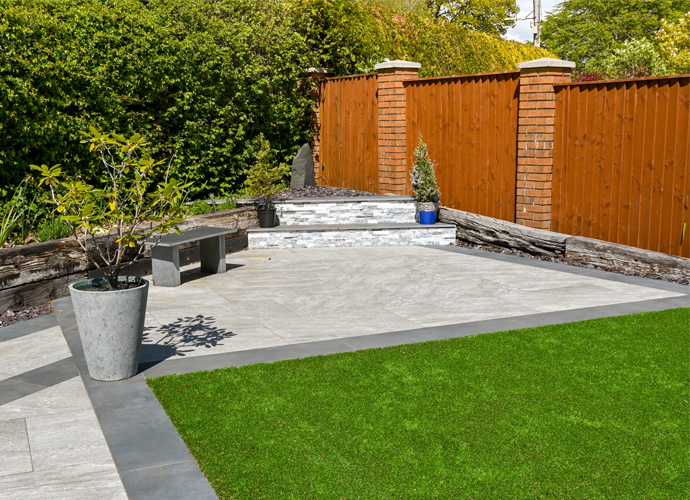When it comes to patios or paths in our gardens it is quite common to pop along to a local DIY store and pick up some concrete or buff square paving slabs. Whilst perfectly acceptable and practical, these can be a little bit unexciting. In this article we will take a look at the different paving slab options and we will explore how to decide which type of slabs to get as each has its own pros and cons.

Natural Stone
Natural stone, as it says, has been produced by nature, it is extremely hard wearing and very frost resistant. On top of that it only looks better with age, it’s easy to clean and, due to its quality image it can add value to a property. There are some downsides, though. The main one for most people is that the colours and pattern are not uniform and this can lead to there being shade or pattern variations across the patio or path. There are 4 types of natural stone paving slabs:
- Sandstone – this is a type of stone where small, individual particles are help together by a silicon cement. These are often called Riven paving slabs. Sandstone comes in many different colours from grey to red and, if they have a good amount of silicone they can be very very durable. On the downside, the surface can be very rough and erosive and the colours can fade over time due to the bad weather so the slabs do need some looking after
- Limestone – this stone is similar to sandstone but the particles are bound simply by pressure. Limestone tends to have much more consistent colours which tend to be softer than sandstone. In addition, limestone slabs aren’t as rough on the surface. The cons of limestone is that it is much more susceptible to colour fading than sandstone, the colour range is limited and the stone can be damaged by acids very easily.
- Granite – this igneous stone comes in a huge range of colours and finishes. Due to its mineral make up, granite is perhaps the most hard wearing of all the natural stones and it is also the least porous making it the most frost resistant. The main downsides are the cost, which is, by far the highest and it is very hard to work granite. It is very labour intensive and difficult.
- Slate – this stone is formed in layers from metamorphic stone rather than particles. It is important, to ensure an even thickness of the slabs to get calibrated slate. This is slate that has been run through a machine which takes off the back to give an even thickness. Slate is very durable and unlikely to fade over time and is extremely frost resistant due to its low porosity. Slate can be brittle though and hard to work with and the textured surface can flake off over time through simple use.
Porcelain
As with wall tiles, paving slabs can also be made from porcelain. These slabs are fired at very high temperatures using moulds and repeatable patterns. This means that they are always 100% uniform in size, colour and patterns. Porcelain can even be made to replicate natural stone. Porcelain has an almost 0% porosity, is very easy to clean and also very hard wearing. Although porcelain fixes some of the issues with stone, like variations in colour and porosity, it is very hard to cut and lay. It needs a primer to allow it to be properly bedded into the mortar and specialist cutting blades making it a bit more challenging to work with.
Concrete
Perhaps the lowest cost option, man made concrete slabs can come in a variety of colours and patterns and textures and will be very consistent. Concrete is easy to work with and continues to harden and become more durable with time. If a slab needs replacing this tends to be pretty simple and the new slab will most likely still match. The main issue with concrete slabs is that they are prone to cracking if not laid really robustly or if the ground moves slightly, which it can. In addition, concrete slabs are prone to staining which does make them discolour over time, this can be fixed by sealing them.
There is a large range of paving slabs on the market and the choice of which ones to use is going to be budget orientated, your garden and of course your personal preference. Whatever choice you make, however, ensure that they are laid professionally and you will get years of enjoyment out your lovely patio or path.






